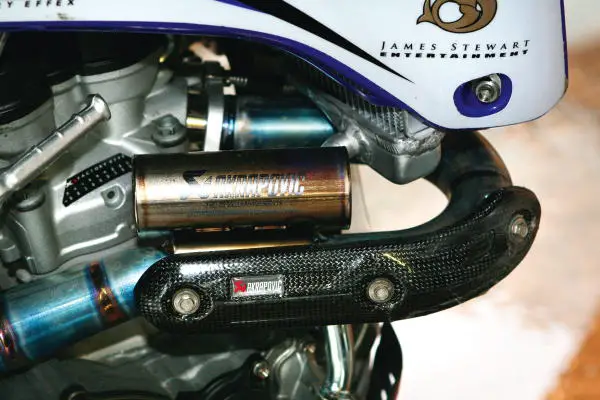TEN THINGS YOU NEED TO KNOW ABOUT RESONANCE CHAMBERS

(1) Exhaust is very similar to alternating current. A high-pressure exhaust note is followed immediately by an opposing low-pressure note. With AC current, positive and negative cycles of voltage combine to provide a steady 120-plus volts of electricity. On a bike, the consistent cycles of positive and negative exhaust waves combine to give the engine a ridable powerband.
(2) A sinusoid is a function that occurs when exhaust is sent out a pipe (or electricity is sent to a house). The power represents periodic oscillations in which the amplitude, shape and timing of the positive displacement is proportional to the negative displacement on the other end of the scale.
(3) The high- and low-sinusoid pressures of the exhaust note travel in opposite directions. The low-pressure wave creates the reflective pulse that is better known as back pressure. Back pressure is used to silence the bike as well as to control the delivery of power.
(4) During the engine’s final cycle (the fourth stroke) there is an overlap when both the intake and exhaust valve are open at the same time. During that event, a properly tuned exhaust pipe minimizes the reflective exhaust pressure pulse. If the exhaust waves are managed correctly, the incoming fuel/air charge dances right into the cylinder and makes the most possible power. Excessive exhaust back pressure at the moment that both valves are open impedes intake and slows the engine down.
(5) A resonating chamber is nothing more than an empty box. In function, it is a muffler that uses dead air space instead of packing. The exhaust note gets into the resonating chamber through one or more small bleed holes. The resonating chamber creates an interference in exhaust flow and uses the positive and negative sound waves to cancel each other out. A chamber also gives the tuner more options for minimizing back pressure at the crucial moment of valve overlap.
(6) What the pipe tuner searches for is the ultimate combination of muffler, resonator, tuned length, tubing diameter, pipe volume and shape. He has to make more power, reduce the weight over the stock pipe and meet the AMA’s new 115dB two-meter-max sound limit. A tuner who uses a resonating chamber properly can find an additional one decibel reduction in sound with absolutely no effect on performance; it’s even possible to gain performance.
(7) The typical resonating chamber is 1-1/2 inches in diameter and seven-inches long. The chamber volume is generally bigger on a 450 than a 250. A bigger chamber with the proper-sized bleed hole has a greater effect on sound and power than a small chamber with a small hole.
(8) In a pipe, exhaust wall pressure is highest at low emission velocities. It is at this moment that the resonating chamber provides the most sound and power benefits. At higher rpm, the exhaust emission velocity is too great (and the wall pressure is low). This is where a poorly designed resonating chamber can hurt power by disrupting smooth exhaust flow?either with too much volume, too many bleed holes, or holes that are too large.
(9) Resonating chambers that use a sharp step in diameter have a greater effect on minimizing the reflective pulse. A resonating chamber like this is best used to tune low rpm power. A more tapered chamber size shifts the resonating effect higher up in the rpm range.
(10) A resonating chamber typically adds two to five ounces to the weight of a pipe. It looks like it would weigh more, but it is largely air. Resonance chambers can be good and they can be bad. The trick is to tune the volume to create the perfect cancellation between the positive and negative pressure waves. This is an equation that requires lots of trial and error.




Comments are closed.